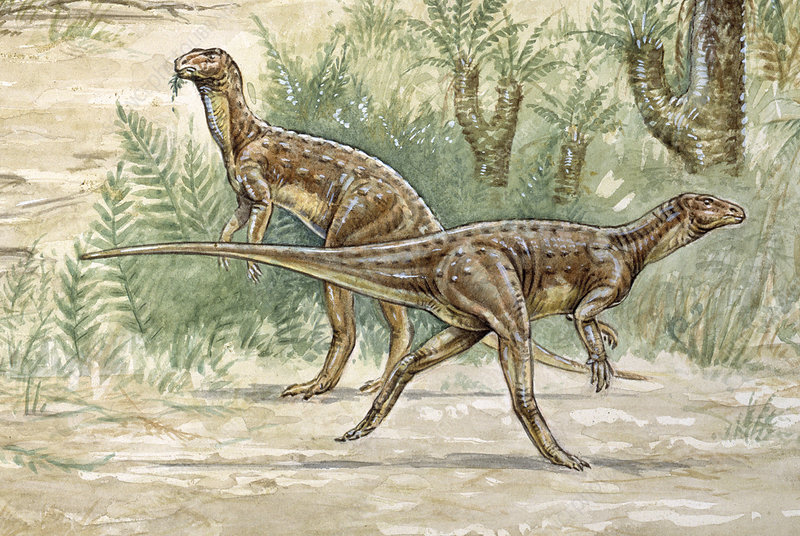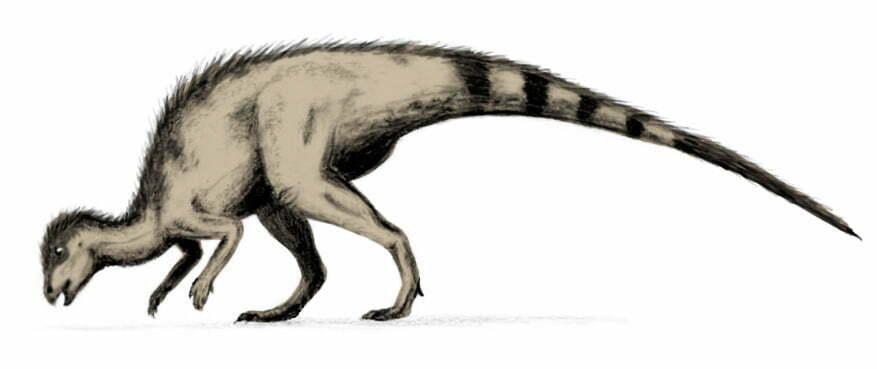(Dinosaur) Hypsilophodon
“Miniature Dinosaur Hops into Your Heart – Meet the Hypsilophodon!”

The Hypsilophodon is a small, herbivorous dinosaur, a fascinating relic from Earth’s ancient past. Standing at about 3 feet tall and measuring around 6.5 feet in length, it’s relatively diminutive compared to some of its larger dinosaur counterparts. Despite its small stature, this dinosaur boasts some unique characteristics that set it apart.
One of the most striking features of the Hypsilophodon is its slender and agile build. Its body is designed for swift movement, and it has evolved to be an adept runner. This creature’s long, graceful legs, along with its bipedal stance, enable it to dart through the prehistoric landscape with ease.
To maintain balance and agility during its sprints, the Hypsilophodon sports an elongated tail. This tail also plays a crucial role in its movement, assisting it with quick turns and maneuvers when navigating the terrain.
The Hypsilophodon’s head features a pointed snout filled with sharp, leaf-shredding teeth, which it uses to graze on the vegetation in its environment. These specialized teeth help it extract nutrients from the plant matter it consumes. Its sense of smell is keen, allowing it to detect food sources and potential dangers.
In addition to its sharp olfactory senses, the Hypsilophodon boasts sharp eyes, which provide it with excellent vision. This visual acuity is a valuable asset when scanning for predators or identifying potential food.
These dinosaurs are known for their social nature and often travel in herds. Living in groups enhances their chances of survival as they can alert one another to approaching threats and help deter would-be predators. Their ability to move quickly and change direction rapidly is a significant advantage when evading danger.
The Hypsilophodon’s existence in prehistoric ecosystems provides valuable insights into the diverse range of adaptations and behaviors exhibited by Earth’s ancient inhabitants. It serves as a captivating subject of study for paleontologists and offers a glimpse into the fascinating world of the past.
Hypsilophodon 5e
Hypsilophodon 3.5 Homebrew
Hypsilophodon
Small beast, unaligned
Armor Class 13 Hit Points 26 (4d6 + 12) Speed 50 ft.
| STR | DEX | CON | INT | WIS | CHA |
|---|---|---|---|---|---|
| 10 (+0) | 16 (+3) | 16 (+3) | 2 (-4) | 12 (+1) | 6 (-2) |
Skills Perception +3 Senses passive Perception 13 Languages understands Draconic but can’t speak
Challenge 1/4 (50 XP)
Keen Sight. It has advantage on Wisdom (Perception) checks that rely on sight.
Pack Tactics. The Hypsilophodon has advantage on an attack roll against a creature if at least one of the Hypsilophodon’s allies is within 5 feet of the creature and the ally isn’t incapacitated.
Multiattack. The Hypsilophodon makes two attacks: one with its bite and one with its claws.
- Bite. Melee Weapon Attack: +5 to hit, reach 5 ft., one target. Hit: 8 (1d8 + 3) piercing damage.
- Claws. Melee Weapon Attack: +5 to hit, reach 5 ft., one target. Hit: 6 (1d6 + 3) slashing damage.
Actions
- Fleet-footed Dash. The Hypsilophodon moves up to its speed and can make a Dexterity (Acrobatics) check to avoid opportunity attacks from creatures. If it succeeds, no opportunity attacks are triggered.
- Skittish Dodge. As a reaction, the Hypsilophodon can impose disadvantage on an attack roll targeting it.
Description
The Hypsilophodon is a small, swift dinosaur with keen senses. It is often found in herds, relying on its agility and social nature to outmaneuver predators. This dinosaur is known for its slender build, elongated tail, and sharp teeth, making it an adept herbivore.
Incorporating the Hypsilophodon into your campaign can add an element of prehistoric wonder and challenge for your adventurers. Whether encountered in herds or as solitary creatures, they can present interesting scenarios, particularly when navigating their skittish, nimble nature.

A small creature strays from the others. You look at it small, unthreatening body and find it cute that such an animal exists. It looks at you over its beak-like mouth an then flees with unbelievable speed.
Originally Posted by Darknecromancer of the Wizards Community forums.
A Hypsilophodon is a small, bipedal plant-eater that lives in large groups for its entire life. They are preyed on by almost all predators and are practically the bottom of the food chain. The one thing they have on their side is speed, and lots of it.
| Hypsilophodon | |
| Medium animal | |
| Hit Dice | 1d8 (4 hp) |
| Initiative | +2 (+2 Dexterity) |
| Speed | 40 ft. (8 squares), Burrow 5 ft. |
| Armor Class | 13 (+2 Dexterity, +1 natural), touch 12, flat-footed 11 |
| Base Attack/Grapple | 0/-1 |
| Attack | Bite -1 melee (1d3 -1) |
| Full Attack | Bite -1 melee (1d3 -1) |
| Space/Reach | 5 ft./5 ft. |
| Special Attacks | – |
| Special Qualities | Low-Light Vision, Scent |
| Saves | Fort +2, Ref +4, Will +2 |
| Abilities | Strength 8, Dexterity 15, Constitution 11, Intelligence 2, Wisdom 14, Charisma 10 |
| Skills | Listen +4, Spot +4 |
| Feats | Run |
| Environment | Warm forests |
| Organization | Solitary, Pair, Family (2-5), or Nest (5-20) |
| Challenge Rating | 1/2 |
| Treasure | None |
| Alignment | Always neutral |
| Advancement | 2-3 HD (Medium) |
| Level Adjustment | – |
Combat
A Hypsilophodon will try to avoid combat at every opportunity. They would much rather flee than fight, but if seriously threatened they will attempt to defend themselves with their feeble beaks.
Society
A Hypsilophodon is never alone for long. They know they are too small to survive on their own. If something threatens one of them, others will flee unless the creature is equal in size to them and alone. If such is the case, The others will try to cluster around the predator to scare it off.

 Buy me a coffee
Buy me a coffee